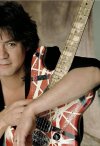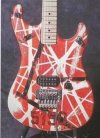How were you able to get the Floyd slammed down on the body like that? I’m wondering what the angles and depths in the neck pocket would have to be to achieve that sort of setup.
On forums about EVH 5150 there is a misconception that the old FRT5 Floyd used a deeper neck pocket than the later Schaller one. Let's get this out of the way first.
A bit of background on the Kramer Pacer body;
These were built out of house by a company called Sports originally to take a fender style 6 screw bridge and in order for the neck to sit at a similar hight over the body as a strat with the pick guard on the neck pocket was made deeper by about 3mm but still straight and well inside the adjustment of the bridge they were using.
First change was the new Rockinger tremolo which also fitted the same geometry.
Now we go to the FRT5 Floyd. This requires more string hight at the bridge than a straight neck could give unless you either; 1 cut the neck pocket less deep or ; 2 put a shim or add a shallow angle to the pocket so the string hight could accommodate the new Floyd floating slightly.
The first FRT5 are flat with a big shim and then subsequently a small angle was added to give a bit of space to float the bridge.
If you look at 5150 you can clearly see the deep set slightly angled neck.
The angled pocket with the slight leeway remained unchanged when the Schaller Floyd became standard because it was well inside the adjustment range of the FRT5 floating. The Schaller baseplate is about 1mm thicker than the FRT5.
Now how to get the EVH setup flat on the body with the right action and it actually working properly:
The finished guitar is a Musikraft pacer cut with a neck pocket angle to give the Floyd room. It is about 18mm deep at the back and 1~2 degrees slope to the front. My German 1984(original) Floyd has had the intonation bolts ground to the exact thickness of the baseplate (so no protruding) and the leading edge of the baseplate has a bevel cut so that when you press down the bar it does not crash the underside (of the baseplate) in to the body causing it to dislocate on the posts if you continued to press down. All German Floyds need this mod or a clearance hight to work properly. Wolfgangs have a channel routed instead to produce the same clearance. The Gotoh 1996 has the bevel already and works far better in this situation.
Now you have the Floyd flat or close you need to look at the action. In an ideal world no neck shim and the Floyd flat and resting would give you 1mm action and you could then slightly tweak the posts to fine tune. BUT this is hardly ever the case and you need to get the action you want almost entirely using neck shims until you get close enough to tweak the posts.
This set up is probably the hardest to get right in the whole business. At least you can just remove the neck and Floyd without even detuning it. WTF I hear you say. If you hold the Floyd bar to the back to keep tension you can remove the springs. Now carefully allow the trem to just tilt up to its max and you can carefully unhook it from the posts. Effectively no string tension remains and with the tension off you can remove the neck.
If you reverse this you will find it is still in tune. Do that with a Bigsby!


